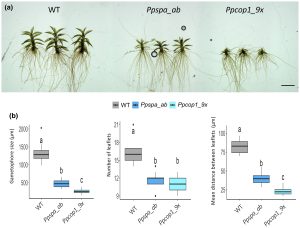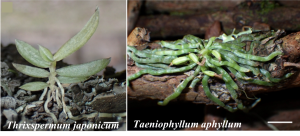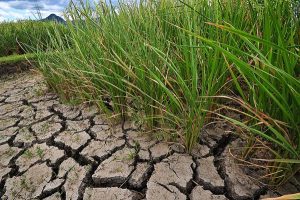Plant Science Research Weekly: March 31, 2023
Special feature: Harnessing crop diversity
 Don’t miss this excellent set of articles on the topic of crop diversity, organized by Susan McCouch, Loren Rieseberg, with Pamela Ronald. It includes five perspectives and six research articles, on topics such as breeding technologies and international policies. As the editors observe, having a very narrow range of crop diversity is both risky (more vulnerable to pandemics and climate impacts) and unhealthful (restricts the nutrient range of the human diet). Articles in this Special Feature call for enhanced protection of germplasm diversity both in situ (in the environment) and ex situ (in seed banks). Strategies to use crop diversity towards improved plant varieties and agroecosystems are discussed. I learned a lot from this collection, including about the Local Contexts initiative https://localcontexts.org/, “a global initiative that supports Indigenous communities with tools that attribute cultural authority of heritage and data” – check out the video for more information on the Traditional Knowledge labels. (Summary by Mary Williams @PlantTeaching) Proc. Natl. Acad. Sci. USA https://www.pnas.org/topic/550
Don’t miss this excellent set of articles on the topic of crop diversity, organized by Susan McCouch, Loren Rieseberg, with Pamela Ronald. It includes five perspectives and six research articles, on topics such as breeding technologies and international policies. As the editors observe, having a very narrow range of crop diversity is both risky (more vulnerable to pandemics and climate impacts) and unhealthful (restricts the nutrient range of the human diet). Articles in this Special Feature call for enhanced protection of germplasm diversity both in situ (in the environment) and ex situ (in seed banks). Strategies to use crop diversity towards improved plant varieties and agroecosystems are discussed. I learned a lot from this collection, including about the Local Contexts initiative https://localcontexts.org/, “a global initiative that supports Indigenous communities with tools that attribute cultural authority of heritage and data” – check out the video for more information on the Traditional Knowledge labels. (Summary by Mary Williams @PlantTeaching) Proc. Natl. Acad. Sci. USA https://www.pnas.org/topic/550
Seeing clearly: Plant anatomy through Katherine Esau’s microscopy lens
 This is a fun and interesting paper that combines two threads, a historical overview of the many contributions of Katherine Esau to plant anatomy (many of you have her book on your shelf) and the historical advancements in microscopy. Geitmann weaves these threads together by putting Esau’s drawings of plant structures side-by-side with contemporary images created by various types of microscopes. It’s an excellent and beautifully illustrated primer of the field of microscopy, and also an impressive display of the genius of Katherine Esau. I hope you enjoy reading it as much as I did. (Summary by Mary Williams @PlantTeaching) J. Microscopy 10.1111/jmi.13179
This is a fun and interesting paper that combines two threads, a historical overview of the many contributions of Katherine Esau to plant anatomy (many of you have her book on your shelf) and the historical advancements in microscopy. Geitmann weaves these threads together by putting Esau’s drawings of plant structures side-by-side with contemporary images created by various types of microscopes. It’s an excellent and beautifully illustrated primer of the field of microscopy, and also an impressive display of the genius of Katherine Esau. I hope you enjoy reading it as much as I did. (Summary by Mary Williams @PlantTeaching) J. Microscopy 10.1111/jmi.13179
One hundred important questions facing plant science: An international perspective
 In 2011, a group of scientists published an article called “One hundred important questions facing plant scientists”. Now, Armstrong et al. have provided an updated version of this, with an additional effort to draw on contributions from the global community, including non-specialists, to identify key questions. An interesting outcome is the notable increase in the number of questions and frequency with which the questions highlight concerns about climate change, reflecting the growing awareness of its importance and impact. The authors of the new work also point out that many of the highlighted questions are best addressed using interdisciplinary teams. Finally, they point out that by including the voices of the non-specialists, they created a culture of equity where non-specialists’ ideas carried weight alongside those of experts. (Summary by Mary Williams @PlantTeaching) New Phytol. 10.1111/nph.18771
In 2011, a group of scientists published an article called “One hundred important questions facing plant scientists”. Now, Armstrong et al. have provided an updated version of this, with an additional effort to draw on contributions from the global community, including non-specialists, to identify key questions. An interesting outcome is the notable increase in the number of questions and frequency with which the questions highlight concerns about climate change, reflecting the growing awareness of its importance and impact. The authors of the new work also point out that many of the highlighted questions are best addressed using interdisciplinary teams. Finally, they point out that by including the voices of the non-specialists, they created a culture of equity where non-specialists’ ideas carried weight alongside those of experts. (Summary by Mary Williams @PlantTeaching) New Phytol. 10.1111/nph.18771
Unlocking the secrets of light signaling in Physcomitrium: A collaborative effort by COP1, SPA, and cryptochrome
 The water-to-land transition increased plant complexity, requiring endogenous developmental programs to be linked to light signal transduction pathways to adapt to ambient light. Arabidopsis COP1 (CONSTITUTIVE PHOTOMORPHOGENIC 1) and SPA (SUPRESSOR OF PHYA-105) proteins represses photomorphogenesis under darkness. SPA genes are green lineage-specific, while COP1 is ancient and found in mammals. Mammalian COP1 functions without SPA auxiliary proteins. When did COP1 and SPA co-action evolved? To answer this question, the researchers generated Ppcop1 mutants and compared with the Ppspa in the moss Physcomitrium patens. Their results show that Ppcop1 and Ppspa show resemblance in their phenotypes- both produce green chloroplasts in complete darkness. They also exhibited disturbed branching of protonema and loss of gravitropism. In addition, they found that the PpCOP1 and PpSPA interacted with cryptochrome in blue light which is similar to the interaction of Arabidopsis SPA with CRY1. When compared to their Arabidopsis homologs, the COP1 and SPA proteins in Physcomitrium display partial inhibition of light signaling under darkness which suggests that additional proteins may exist which contribute to completely repressing the light signaling in darkness. (Summary by Arpita Yadav @arpita_yadav_). Plant J. 10.1111/tpj.16128
The water-to-land transition increased plant complexity, requiring endogenous developmental programs to be linked to light signal transduction pathways to adapt to ambient light. Arabidopsis COP1 (CONSTITUTIVE PHOTOMORPHOGENIC 1) and SPA (SUPRESSOR OF PHYA-105) proteins represses photomorphogenesis under darkness. SPA genes are green lineage-specific, while COP1 is ancient and found in mammals. Mammalian COP1 functions without SPA auxiliary proteins. When did COP1 and SPA co-action evolved? To answer this question, the researchers generated Ppcop1 mutants and compared with the Ppspa in the moss Physcomitrium patens. Their results show that Ppcop1 and Ppspa show resemblance in their phenotypes- both produce green chloroplasts in complete darkness. They also exhibited disturbed branching of protonema and loss of gravitropism. In addition, they found that the PpCOP1 and PpSPA interacted with cryptochrome in blue light which is similar to the interaction of Arabidopsis SPA with CRY1. When compared to their Arabidopsis homologs, the COP1 and SPA proteins in Physcomitrium display partial inhibition of light signaling under darkness which suggests that additional proteins may exist which contribute to completely repressing the light signaling in darkness. (Summary by Arpita Yadav @arpita_yadav_). Plant J. 10.1111/tpj.16128
Cortical microtubules contribute to division plane positioning during telophase in maize
 During plant cell division, the new cell wall is built along a plant-specific structure named the phragmoplast. The phragmoplast is a complex array of microtubules and microfilaments that originates at the middle of the cell and expands outwards to the division site at the cell cortex. The proper orientation of the cell division depends upon the phragmoplast precisely reaching to the designated division site. However, it is not fully understood what guides the phragmoplast to reach the correct location. In this recent study, Bellinger et al. discovered that a microtubule binding protein named TANGLED1 (TAN1) facilitates the proper orientation of the phragmoplast in maize epidermal cells. They found that microtubules accumulate at the cortex during telophase, in an abundant and organized manner, before the phragmoplast contacts the cortex. In the tan1 mutant, which has phragmoplast orientation defects, the cortical microtubules are arranged in a more variable way. Previously, TAN1-YFP has been shown to form discrete puncta at the cortical division site during telophase. In this study, the authors found that cortical-telophase microtubules interact with stable TAN1 puncta at the division site, and remain near the TAN1 puncta longer than other regions, which suggests that TAN1 facilitates the pausing and capturing of cortical microtubules near the division site. A future direction would be to identify the factors that modulate the targeting of TAN1 to the division site. (Summary by Xiaohui Li @Xiao_hui_Li, and edited by Carolyn Rasmussen @carolynplants) Plant Cell 10.1093/plcell/koad033
During plant cell division, the new cell wall is built along a plant-specific structure named the phragmoplast. The phragmoplast is a complex array of microtubules and microfilaments that originates at the middle of the cell and expands outwards to the division site at the cell cortex. The proper orientation of the cell division depends upon the phragmoplast precisely reaching to the designated division site. However, it is not fully understood what guides the phragmoplast to reach the correct location. In this recent study, Bellinger et al. discovered that a microtubule binding protein named TANGLED1 (TAN1) facilitates the proper orientation of the phragmoplast in maize epidermal cells. They found that microtubules accumulate at the cortex during telophase, in an abundant and organized manner, before the phragmoplast contacts the cortex. In the tan1 mutant, which has phragmoplast orientation defects, the cortical microtubules are arranged in a more variable way. Previously, TAN1-YFP has been shown to form discrete puncta at the cortical division site during telophase. In this study, the authors found that cortical-telophase microtubules interact with stable TAN1 puncta at the division site, and remain near the TAN1 puncta longer than other regions, which suggests that TAN1 facilitates the pausing and capturing of cortical microtubules near the division site. A future direction would be to identify the factors that modulate the targeting of TAN1 to the division site. (Summary by Xiaohui Li @Xiao_hui_Li, and edited by Carolyn Rasmussen @carolynplants) Plant Cell 10.1093/plcell/koad033
Roots are the ‘kitchen’ for leafless epiphytic orchids
 Photosynthesis is the major process which supports plant survival. It’s the kitchen serving food (sugars) to the plant by converting the light energy. Leaves are the major site of photosynthesis for most plants. However, certain plants evolved unconventional ways of performing photosynthesis. In a recent study, Suetsugu et al. discovered an epiphytic orchid (Taeniophyllum aphyllum) photosynthesising via its roots. Compared to its co-occurring leafy counterpart, Thrixspermum japonicum, pigment content in T. aphyllum roots was double, similar to that in T. japonicum leaves. T. japonicum roots also performed photosynthesis, but the electron transport rate and photosynthetic efficiency were much lower than T. japonicum leaves or T. aphyllum roots, suggesting a subsidiary role. The high nocturnal carbon fixation by T. aphyllum roots and T. japonicum leaves indicated an efficient crassulacean acid metabolism (CAM) cycle compared to the C3 cycle in T. japonicum roots. Unlike the C3 cycle, CAM photosynthesis involves temporal separation of photosynthesis and carbon dioxide (CO2) fixation to reduce water loss. The higher number of pneumathodes (aeration cells) in roots probably functioned as stomata in the leaves for CO2 uptake, malate accumulation and nocturnal CO2 fixation. The chloroplast ultrastructure was also similar in roots and leaves, suggesting that morphological sophistication in roots allowed them to act as photosynthetic organ. Further research on the evolutionary role which transferred CAM photosynthesis from leaves to roots, allowing leafless adaptation, will be fascinating. (Summary by Rajarshi Sanyal @rajarshi_sanyal) New Phytol. 10.1111/nph.18812
Photosynthesis is the major process which supports plant survival. It’s the kitchen serving food (sugars) to the plant by converting the light energy. Leaves are the major site of photosynthesis for most plants. However, certain plants evolved unconventional ways of performing photosynthesis. In a recent study, Suetsugu et al. discovered an epiphytic orchid (Taeniophyllum aphyllum) photosynthesising via its roots. Compared to its co-occurring leafy counterpart, Thrixspermum japonicum, pigment content in T. aphyllum roots was double, similar to that in T. japonicum leaves. T. japonicum roots also performed photosynthesis, but the electron transport rate and photosynthetic efficiency were much lower than T. japonicum leaves or T. aphyllum roots, suggesting a subsidiary role. The high nocturnal carbon fixation by T. aphyllum roots and T. japonicum leaves indicated an efficient crassulacean acid metabolism (CAM) cycle compared to the C3 cycle in T. japonicum roots. Unlike the C3 cycle, CAM photosynthesis involves temporal separation of photosynthesis and carbon dioxide (CO2) fixation to reduce water loss. The higher number of pneumathodes (aeration cells) in roots probably functioned as stomata in the leaves for CO2 uptake, malate accumulation and nocturnal CO2 fixation. The chloroplast ultrastructure was also similar in roots and leaves, suggesting that morphological sophistication in roots allowed them to act as photosynthetic organ. Further research on the evolutionary role which transferred CAM photosynthesis from leaves to roots, allowing leafless adaptation, will be fascinating. (Summary by Rajarshi Sanyal @rajarshi_sanyal) New Phytol. 10.1111/nph.18812
Improving harvest index under drought stress in rice
 Harvest index (HI) is the ratio of grain yield to the sum of grain, leaf, and stem biomass. HI is affected by environmental conditions such as water availability. Previously, carbohydrate remobilization from stem to grain has been shown to be affected by drought (which in rice contributes to C remobilization) and to contribute to HI. In an effort to improve HI under drought conditions and to untangle plant water status from C remobilization, Dwivedi et al. (2023) observed plant water status and carbohydrate remobilization in stems of 12 rice genotypes. Unlike drought-sensitive genotypes, drought-tolerant genotypes can produce stable HI in both drought and well-watered conditions. In these genotypes, the availability of water facilitates enhanced carbohydrate accumulation and remobilization, as observed from the increased starch content in the stems. However, drought induces carbohydrate remobilization into grains during the filling stage as a temporary response to water deficiency. Thus, drought-responsive genotypes produce significantly higher HI in drought conditions than well-watered medium. Nevertheless, drought-responsive genotypes show poor carbohydrate remobilization at maturity because stomatal conductance is decreased. Therefore, Dwivedi et al. suggest selecting drought tolerant varieties like Aus 257 and Wanni Dahanala, which show stable HI in both well-watered and drought conditions is useful for crop improvement across different environments. (Summary by Kumanan N Govaichelvan, @NGKumanan). Rice Journal 10.1186/s12284-023-00631-6
Harvest index (HI) is the ratio of grain yield to the sum of grain, leaf, and stem biomass. HI is affected by environmental conditions such as water availability. Previously, carbohydrate remobilization from stem to grain has been shown to be affected by drought (which in rice contributes to C remobilization) and to contribute to HI. In an effort to improve HI under drought conditions and to untangle plant water status from C remobilization, Dwivedi et al. (2023) observed plant water status and carbohydrate remobilization in stems of 12 rice genotypes. Unlike drought-sensitive genotypes, drought-tolerant genotypes can produce stable HI in both drought and well-watered conditions. In these genotypes, the availability of water facilitates enhanced carbohydrate accumulation and remobilization, as observed from the increased starch content in the stems. However, drought induces carbohydrate remobilization into grains during the filling stage as a temporary response to water deficiency. Thus, drought-responsive genotypes produce significantly higher HI in drought conditions than well-watered medium. Nevertheless, drought-responsive genotypes show poor carbohydrate remobilization at maturity because stomatal conductance is decreased. Therefore, Dwivedi et al. suggest selecting drought tolerant varieties like Aus 257 and Wanni Dahanala, which show stable HI in both well-watered and drought conditions is useful for crop improvement across different environments. (Summary by Kumanan N Govaichelvan, @NGKumanan). Rice Journal 10.1186/s12284-023-00631-6
Optimizing short-format training: Effective, inclusive, and career-spanning professional development
 Short-format training (SFT) provides opportunities for people to acquire knowledge and skills outside of traditional degree-granting programs. Unfortunately, in spite of good intentions, there’s evidence to suggest that the SFTs aren’t always very effective, and that the knowledge gained doesn’t necessarily persist. A group of experts and practitioners of SFT have crafted a set of principles, called the Bicycle Principles to guide the development and practice of SFTs. These include a set of Core Principles (Use best evidence; Be effective; Be inclusive, Promote catalytic learning) and Community Principles that help communities (groups) increase the impact of SFTs through Reach, Scale, and Sustainability. The accompanying website (https://www.bikeprinciples.org/) provides a closer look at specific recommendations to support these principles. All the recommendations are interesting and very informative, but I particularly enjoyed reading and thinking about recommendation L, Develop an implementation strategy for Catalytic Learning. Catalytic learning “prepares the learner to continue/implement new knowledge and positions learners for future self-directed learning.” In other words, for the developers of the SFT to provide structures, resources, and motivation so that the SFT serves as a starting point for ongoing independent learning. (Summary by Mary Williams @PlantTeaching) bioRxiv 10.1101/2023.03.10.531570
Short-format training (SFT) provides opportunities for people to acquire knowledge and skills outside of traditional degree-granting programs. Unfortunately, in spite of good intentions, there’s evidence to suggest that the SFTs aren’t always very effective, and that the knowledge gained doesn’t necessarily persist. A group of experts and practitioners of SFT have crafted a set of principles, called the Bicycle Principles to guide the development and practice of SFTs. These include a set of Core Principles (Use best evidence; Be effective; Be inclusive, Promote catalytic learning) and Community Principles that help communities (groups) increase the impact of SFTs through Reach, Scale, and Sustainability. The accompanying website (https://www.bikeprinciples.org/) provides a closer look at specific recommendations to support these principles. All the recommendations are interesting and very informative, but I particularly enjoyed reading and thinking about recommendation L, Develop an implementation strategy for Catalytic Learning. Catalytic learning “prepares the learner to continue/implement new knowledge and positions learners for future self-directed learning.” In other words, for the developers of the SFT to provide structures, resources, and motivation so that the SFT serves as a starting point for ongoing independent learning. (Summary by Mary Williams @PlantTeaching) bioRxiv 10.1101/2023.03.10.531570



